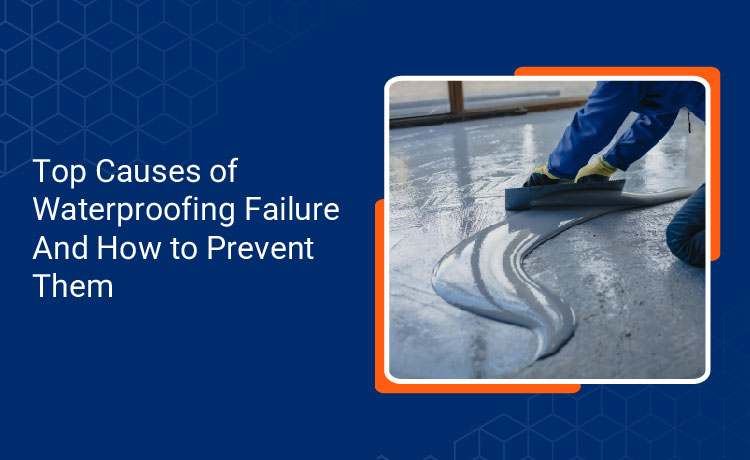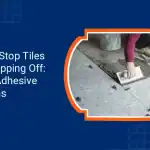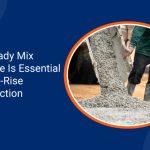 August 7, 2025
August 7, 2025
Have you noticed damp patches, white salt deposits, peeling paint, or swelling plaster on your home’s walls or ceilings, even after a thorough waterproofing solution application? This may be because of a waterproofing failure. But why does it happen, what are the warning signs, and what should you do if you want to safeguard your home from waterproofing failure proactively? In this comprehensive blog post, we have answered all the burning questions.
Waterproofing is essential for preserving the integrity of any structure. It protects key components like walls, floors, and foundations from moisture damage that can lead to cracks, corrosion, and, in the long term, deterioration. Proper waterproofing prevents the growth of mould and mildew, ensuring a healthier indoor environment. It is especially critical in moisture-prone areas such as basements, bathrooms, terraces, and foundations, where water seepage can cause severe structural and aesthetic issues. By investing in quality waterproofing solutions, you not only extend the building’s lifespan but also save on future repair costs and maintain property value.
The common causes of waterproofing failures are as listed below:
Poor surface preparation is one of the major causes of waterproofing materials in construction, as it prevents the waterproofing agents from bonding effectively to the substrate. Uncleaned contaminations, such as dirt, dust, oil, moisture, and even loose particles, create a barrier against waterproofing additives, leading to cracks or uneven surfaces. Therefore, thorough surface preparation is highly crucial before applying any waterproofing solutions.
Different surfaces require different waterproofing materials for proper bonding. When the wrong waterproofing material is applied, it leads to incompatibility with the substrate and is likely to cause premature failures. Therefore, choosing the right material is critical based on the surface type, local climate conditions, and the extent of water exposure around the surface.
Improper installation is the other prime factor that leads to waterproofing failure. It includes inadequate surface preparation, incorrect application techniques, and failure to follow the waterproofing chemicals manufacturer’s application guidelines. Therefore, hire only those professionals who have shown excellent workmanship for constructional installation.
Buildings naturally undergo movement due to temperature changes, settling, and several other factors. This allows water to infiltrate into the gaps, leading to waterproofing failure due to cracks. Consequently, it damages the structural integrity of the building. Natural calamities also cause structural movement, leading to the failure of waterproofing in building construction.
Lack of drainage or water diversion causes water to pool around the waterproofing membrane, creating hydrostatic pressure on the waterproofing system, ultimately contributing to waterproofing failure. Therefore, installing a proper drainage or water diversion is highly crucial to sustain the waterproofing additives.
Continuous exposure to UV (ultraviolet) radiation breaks the chemical bonding of waterproofing solutions, leading to waterproofing problems. UV and weather exposure also degrade the elasticity, making waterproofing materials more susceptible to cracking and damage. Therefore, protecting the waterproofing system against sunlight or rain is equally important.
Waterproofing breaks down over time, requiring regular inspection to delay the ageing process of the waterproofing system. Neglecting maintenance, such as cleaning gutters and resealing joints, can exacerbate the ageing process, leading to cracks or an inability to repel water. Therefore, maintaining the waterproofing system regularly is essential to sustain the waterproofing liquid membranes.
From the signs ranging from damp patches to foul odour, below are the crucial signs that point towards the waterproofing failure:
Preventing waterproofing failure starts with planning and choosing the right system for each area. Different zones like terraces, bathrooms, or basements have varied exposure to water and require tailored waterproofing methods. For example, a terrace may need UV-resistant coatings, while a bathroom needs flexible membrane systems.
Waterproofing is a specialised task that requires precision. Improper mixing, application, or layering can compromise performance. An experienced contractor ensures correct surface preparation, adequate drying time, and uniform application across all joints and surfaces.
Another crucial step is to follow the manufacturer’s guidelines. Every product has its own instructions regarding primer use, layering thickness, curing time, and compatibility with surface types.
Regular inspections are essential, especially in moisture-prone areas. Check for cracks, loose tiles, blocked drainage, or signs of water stagnation. Periodic checks help catch issues before they escalate.
Finally, ensure proper drainage design. Water pooling is one of the biggest causes of waterproofing failure. Slopes should guide water away from the surface, and outlets should remain unclogged. Correcting water flow paths on terraces, balconies, or around foundations ensures long-term performance of any waterproofing system.
MCON Rasayan is a leading construction chemical manufacturer in India. We have been manufacturing and supplying waterproofing solutions across the country for over a decade. Our waterproofing solutions have been a top choice for millions of customers, as our products are infused with the lab-formulated special chemical additives. Doing so makes our waterproofing solutions extremely durable, long-lasting, and available for various substrates. Our high-quality standards and rigorous testing protocols have earned us an ISO certification and the trust of our clients. So, if you are looking for an effective waterproofing solution for your upcoming construction projects, look no further than MCON Rasayan. Contact us today!

Nandan Pradhan, a management degree holder and the Executive Director of MCON Rasayan, is the driving force behind the smooth operation of the organisation. His years of experience in planning, strategising, execution, team training, and ensuring productivity across all areas of company operations have made MCON Rasayan a global leader in the construction chemical manufacturing sector.




